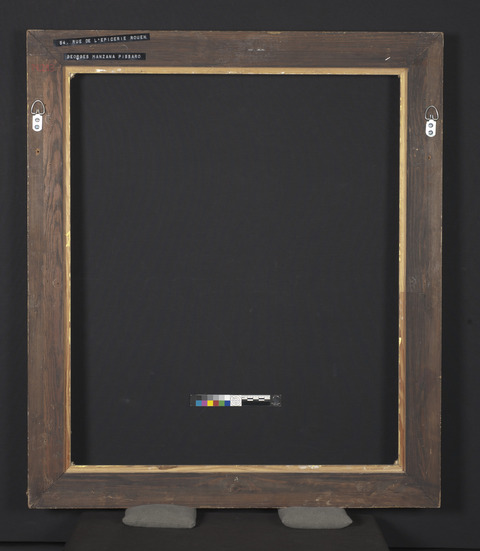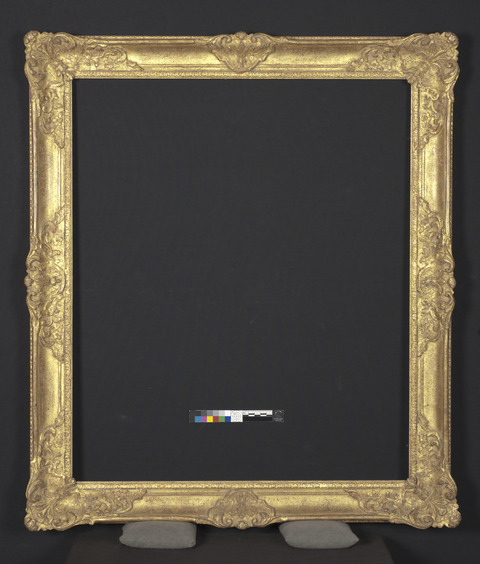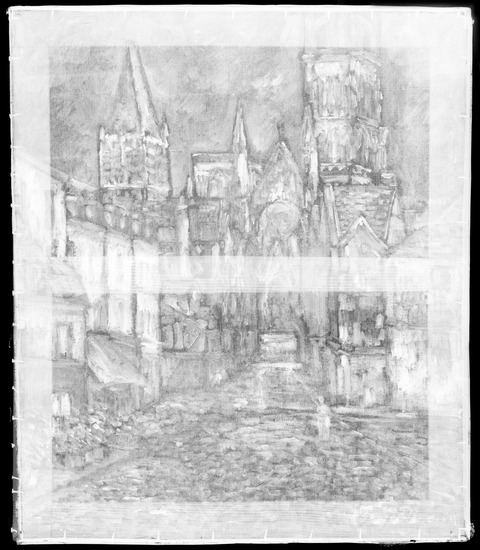OVERVIEW
Identification number: 79.283
Artist: Georges Manzana-Pissarro
Title: Rue de L’Epicerie, Rouen
Materials: Oil on canvas
Date of creation: 1898
Dimensions: 64.77 × 54
Conservator/examiner: Alex Chipkin with contributions from Laura Mosteller and Gregory D. Smith
Examination completed: 2022
Distinguishing Marks
Front:
The painting is signed and dated “Georges Pissarro 98” on the lower-right corner in purple paint. The letters have been emphasized with the addition of lighter paint on the contours. The signature is enmeshed with the paint layers below, painted wet-in-wet (figs. 1, 2).


Back:
There are various inscriptions and labels on the stretcher bars (fig. 3). On the middle horizontal stretcher bar, there is writing in blue that reads “ph 2565.” Beside it is an encircled number 13 in red. There is a brand that reads “MODÈLE DÉPOSÉ” with a letter “B” below, surrounded by a lozenge shape. This indicates the stretcher is from manufacturer Bourgeois aîné. This logo is seen on paintings by Camille Pissarro both in the IMA collection and others.1 A paper label on the top horizontal stretcher from Durand-Ruel displays the addresses from his Paris and New York galleries.2 Other paper labels are from fine art packers and shippers Pitt & Scott and Kaplan Gallery in London. On the canvas, there is a supplier’s stencil that indicates it is from Paul Contet.
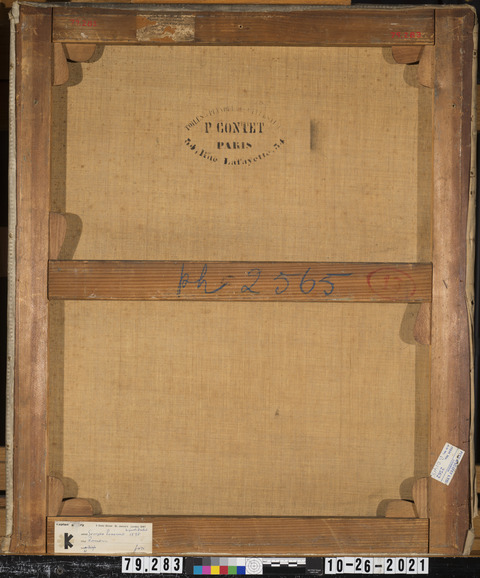
Historical Context
Georges Henri Manzana-Pissarro was the second eldest son of Camille Pissarro, born in 1871, the year that the Franco-Prussian war broke out. Georges started his career as an artist around the same time as his older brother Lucien in 1887. His paintings are Impressionist in style, and later became more decorative, with Orientalist influences. In 1889, his paternal grandmother died, and in 1894 he added her maiden name, Manzana, to his signature. That year, he exhibited at the Second Exhibition of Neo-Impressionist Artists, alongside his two brothers Lucien and Felix.3 It is likely that Rue de l’Epicerie, Rouen was one of nine of his paintings exhibited at the Durand-Ruel Gallery in Paris from 25 March to 6 April 1901.4
Just as he had done with all his children, Camille encouraged Georges to make art. However, Camille often described Georges as unmotivated and erratic in his process. In a letter to Lucien from 26 May 1894, he wrote of 23-year-old Georges:
Neither Titi [Felix] nor Georges have done much work here. They think mostly of blowing false notes on a hunting horn and bicycling through the country and other such pranks that hardly advance their knowledge of values and colors. Georges is very changeable and easily becomes discouraged. At such moments, no efforts! His excuse is that he is waiting for sensations, the old theory of “inspiration.” I have not yet been able to convince him that inspiration, or rather sensation, has to be enticed by regular work every day.5
From the letter, we can understand Camille’s hesitations about Georges and his ways of working. The letters give us insight into George’s personality, albeit from the perspective of his domineering father.
As indicated by the signature and date, Rue de l’Épicerie, Rouen was painted in 1898 in Rouen when Georges was 27 (fig. 2). This same year Camille was painting in this capital city of Normandy from mid-August to mid-October. Camille created several paintings of this main square with the view of the church. His Rue de l’Épicerie, Rouen (Effect of Sunlight) now at the Metropolitan Museum of Art has distinct similarities with Georges’s painting, which depicts the square from almost exactly the same perspective and with the same shadows cast upon the buildings, meaning it was painted at the same time of day (fig. 5). The crowds of people depicted in this work tell us that it was painted on a Friday when there was a market in the main square. In a letter to Lucien from Rouen on 19 August 1898, he writes, “I am forced to go places where I can find attractive and interesting motifs…yesterday I discovered an excellent place, where I hope to paint the rue de l’Epicerie and even the market, a really interesting one, which is held there every Friday."6 We can infer that since there is no crowd depicted in Georges’s work, it was painted on a different day of the week than his father’s work. Georges’s painting has the same coloring, but the paint layers are much less built up than that of his father’s. The tops of the buildings are cropped off in the same way, but the angle is slightly different, making the entrance to the church more visible.
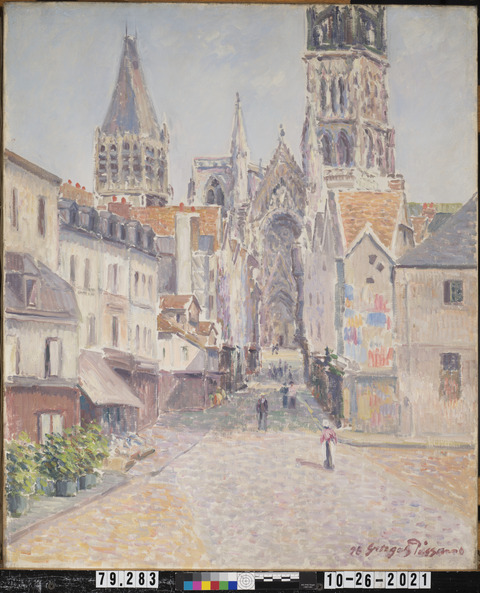

The IMA painting exhibits tack holes at all four corners, which suggests Georges painted the scene from life, en plein air. The holes can be clearly seen in the MA-XRF map for barium, a component of the later inpainting in gouache (fig. 6).7 However, according to Camille’s letters, there is no mention of Georges coming along with his father when he left for Rouen in 1898. The only mention of Georges in this period is when Camille is returning to his house in Eragny, France and writes from Paris, “I shall return to Eragny. I expect Georges today."8
Summary of Treatment History
Rue de l’Epicerie, Rouen was assessed by Chief Conservator Martin J. Radecki in 1982 following its acquisition. He observed that the support is a single piece of extremely fine, slightly open plain-weave linen fabric. He noted that there are small holes visible at each corner. Radecki posited that the ground is a single, thin, off-white proprietary oil formulation. He suggests that the paint is an oil-resin or highly thinned oil paint. He did not detect previous restoration under ultraviolet irradiation. He observed a grime layer over the entire painting with dark accretions on the peaks of the paint along the top edge and lower-left quadrant. 9
Presumably shortly after the examination report was written, the painting was surface cleaned with three applications of a soap and benzine solution following the design elements to avoid tide lines. The dark accretions mentioned above were deemed not removable and inpainted with Windsor and Newton designer gouache.10
Current Condition Summary
Overall, the Rue de L’Epicerie, Rouen is in excellent condition. It remains unlined, and although slightly slack, the canvas is in plane. The painting has few age cracks and the ground and paint layers appear to be stable. It is unvarnished and displays a matte appearance. There is a layer of dirt on the surface, which further contributes to this mattness and causes the colors to appear dull. The proper right edge of the canvas, which is unprimed, is flexible.
Methods of Examination and Imaging
| Examination/Imaging | Analysis (no sample required) | Analysis (sample required) |
|---|---|---|
| Unaided eye | Dendrochronology | Microchemical analysis |
| Optical microscopy | Wood identification | Fiber ID |
| Incident light | Microchemical analysis | Cross-section sampling |
| Raking light | Thread count analysis | Dispersed pigment sample |
| Reflected/specular light | X-ray fluorescence spectroscopy (XRF) | Fourier-transform infrared spectroscopy (FTIR) |
| Transmitted light | Macro X-ray fluorescence scanning (MA-XRF) | Raman microspectroscopy |
| Ultraviolet-induced visible fluorescence (UV) | ||
| Infrared photography (IR) | Gas chromatography–mass spectrometry (GC-MS) | |
| Infrared transmittography (IRT) | Scanning electron microscope -energy dispersive X-ray spectroscopy (SEM-EDS) | |
| Infrared luminescence | Other: | |
| X-radiography |
Technical Examination
Description of Support
Rue de l’Epicerie is painted on a very fine plain-weave linen canvas (untested) with a 34.4 × 34.5 per cm thread count.11 The painting measures 64.77 × 54 mm, which corresponds to a number 15 “Figure” format size pre-stretched canvas (65 × 54mm).12 Tooth marks from canvas pliers used to stretch the canvas onto the auxiliary support are visible on the turnover edges. According to the thread count report compiled by Professor Emeritus at Rice University Don H. Jonson, there is strong cusping along the painting’s left edge (proper right) and weak cusping on all other sides. According to Johnson, this suggests “a significant amount of canvas was trimmed from the right edge after the canvas was prepared.” 13 The proper right edge of the canvas is free of priming layers. The unprimed canvas displays holes from previous tacks not associated with the stretcher and cusping at these holes (discussed further in the Description of Ground section below).
The support of this painting is similar to that of Camille’s Rue de L’Epicerie, Rouen (Effect of Sunlight), mentioned in the Historical Context section above. Both canvases are mounted on Bourgeois âiné stretchers and display a Contet canvas stencil on the back. The stencil has the same mark on the right side, which appears to be a remnant from the stenciling process (fig. 7). The canvas is equally fine, and it displays foxing. Both paintings also have tooth marks from canvas stretching pliers on the turnover edges. The measurements differ, however: the length of the Georges' painting is the same as the width of Camille’s. On the bottom edge, there is raw canvas, free of priming layers, just like the proper right edge of Georges' painting.
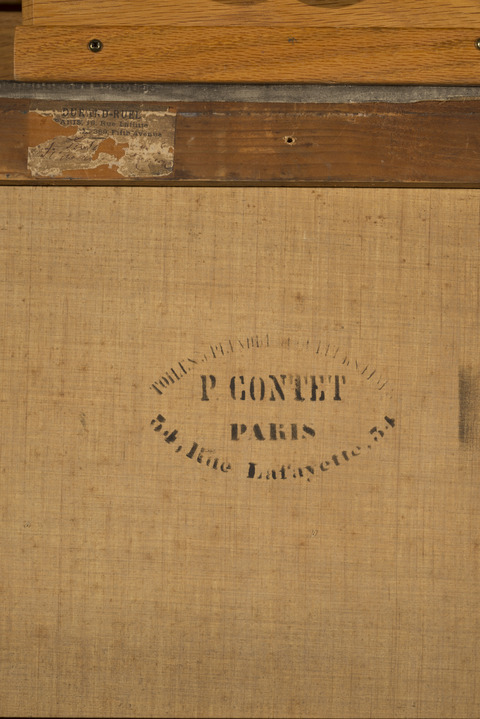
Auxiliary Support:
Original Not original Not able to discern None
Attachment to Auxiliary Support:
The painting is mounted onto a five-member stretcher with mortise and tenon joints at the corners and middle horizontal member. As noted in the Distinguishing Marks section above, there is a Bourgeois aîné manufacturer logo and centered supplier’s stencil that indicate that the painting is on its original stretcher. The tacks correspond to the holes in the stretcher, and there is no evidence that the canvas has ever been removed from the auxiliary support. All 10 stretcher keys are present and appear to be original. They are not secured to the stretcher bars.
Condition of Support
The canvas is slightly slack but holding in good plane for an unlined painting of this age. On the back of the canvas there is what appears to be some dispersed foxing, especially concentrated on the upper part of the painting around the supplier’s stencil. The tacking margin on the proper right side is unprimed and very flexible. The canvas has curled, likely due to handling and changes in relative humidity.
Description of Ground
Materials/Binding Medium:
SEM-EDS detected the presence of lead in the ground layer in a sample from the red-brown façade on the left side of the painting (Sample b). This indicates the ground is composed of lead white (figs. 8–10). It is likely bound in drying oil (untested).

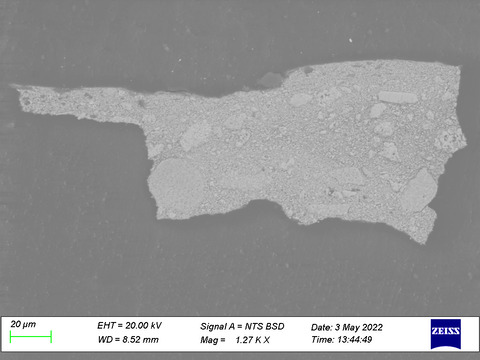

Color:
White
Application:
The painting is primed with one layer of ground. The layer extends to the edges of the canvas on all sides except for the proper right-hand edge. As stated above in the Description of Support, the bare canvas displays prior tack holes not associated with the current stretcher, and cusping is visible at these holes. This suggests that the ground may have been commercially applied and that the edge that is free of ground is where the canvas had been tacked to the previous frame on which the larger bolt of fabric had been prepared.
Thickness:
The ground is applied in a single, thick layer measuring about 50 to 70 micrometers. It is about four to five times thicker than the paint layers above.
Sizing:
Likely gelatin (untested)
Character and Appearance (Does texture of support remain detectable/prominent?):
The single application of ground has conformed to the interstices of the canvas weave, leaving the texture of the canvas visible. This can be clearly seen in the photomicrographs of the edge of the canvas, where the scumbled paint above skips over the texture of the canvas (fig. 11).
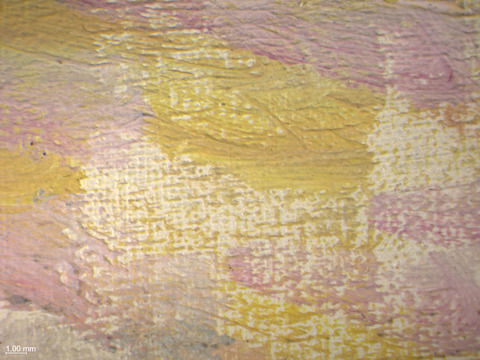
Condition of Ground
The ground is stable and well bound to the support. There are some minor losses to the ground on the corners of the painting that expose the canvas below.
Description of Composition Planning
Methods of Analysis:
Surface observation (unaided or with magnification)
Infrared photography (IR)
X-radiography
Analysis Parameters:
| X-Ray equipment | GE Inspection Technologies Type: ERESCO 200MFR 3.1, Tube S/N: MIR 201E 58-2812, EN 12543: 1.0mm, Filter: 0.8mm Be + 2mm Al |
|---|---|
| KV: | 21 |
| mA: | 3.0 |
| Exposure time (s) | 90 |
| Distance from x-ray tube: | 36 in |
| IRR equipment and wavelength | Modified Nikon D610 camera with a Coastal Optics lens and X-nite 1000C filter |
Medium/Technique:
The painting appears to have been blocked in directly onto the commercially prepared ground with minimal underdrawing. Like the paintings of his father, the compositional forms are blocked out with large spaces in between each element, showing the ground layer. What may be some remnants of carbon-containing underdrawing can be detected in the infrared reflectography mainly on the contours of the tower on the left. A dark haze is apparent around the top of the tower, which may be friable carbon-based medium that had blended with the paint layers above (see fig. 12). Under magnification, black particles can be seen at the contour of the tower on the left, which appear to have been swept into the wet paint (fig. 13). The black particles can be seen at the border of the sky next to the small turret in the middle of the painting as well (fig. 14). Horizontal black linear marks can be observed under magnification joining the tops of the two buildings on the left (fig. 15).

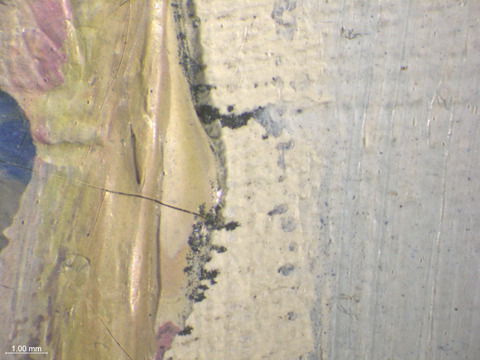
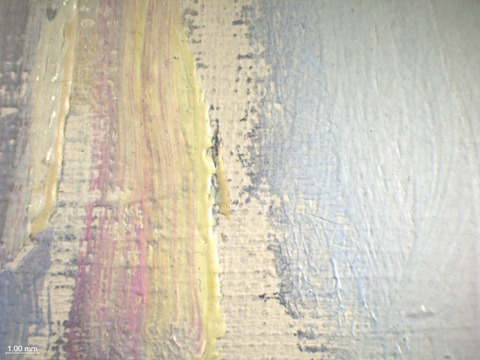
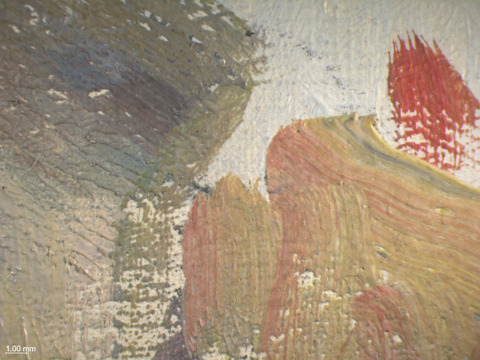
Description of Paint
The majority of the work is painted with very thin, single layers of paint. The texture of the paint is stiff enough to retain brushstrokes and skip acoss the peaks of the canvas weave. There are few areas of impasto; those that exist are located mainly on the contours of objects as well as in areas where adjustments were made or finer details were added (fig. 16, 17).

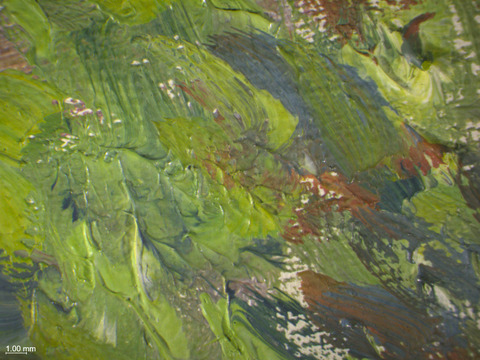
Application and Technique:
Most compositional elements appear to have been built up around the same time in the painting process (fig. 18). However, evidence of wet-in-wet application of the paint is minimized by the fact that the artist left spaces between each object, as noted in the Description of Composition Planning section (fig. 19). The sky appears to have been allowed to dry before some details were added on top. This can be seen, for example, in the depiction of the spires atop the tower on the right (fig. 20) and the red chimney flues on the left (fig. 21). This simple composition calls to mind his father’s technique of initial blocking out the main parts of the composition with large swaths of color separated by spaces. In Camille’s case though, after this initial blocking out, he would continue to build up the paint layers and mostly cover over these spaces. This resulted in more modulated forms and an overall more textured painting in Camille’s work.
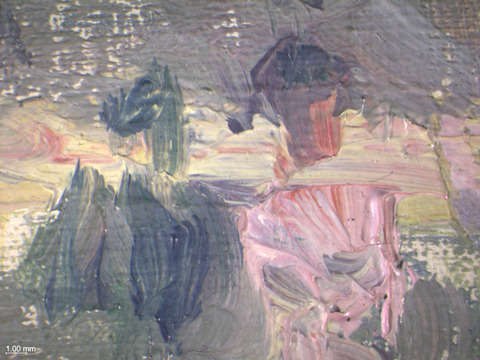
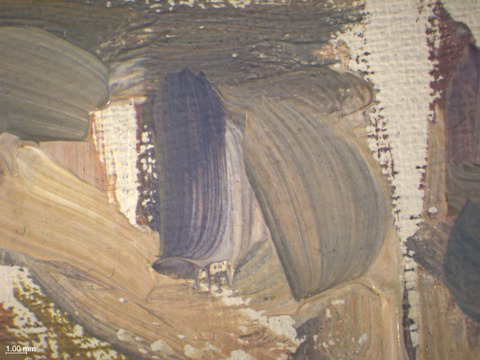
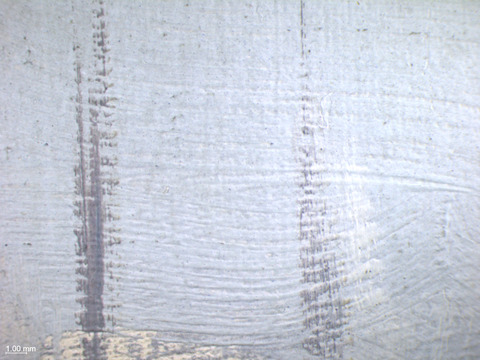
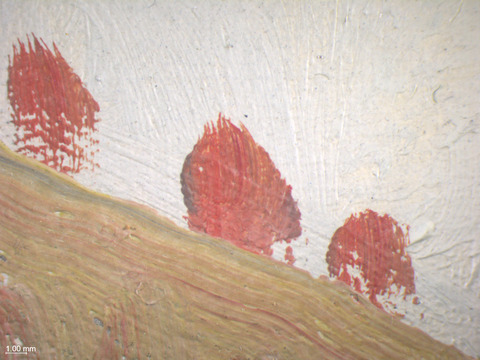
Painting Tools:
To produce this work, Georges used stiff, medium-sized round brushes. The width of the brushstrokes is consistent throughout the painting, measuring an average of 5 mm. It appears that he used only one to two brushes to paint the entire work.
Binding Media:
Oil (untested)
Color Palette:
Cobalt was detected with the use of MA-XRF in the cool grays used for the turret on the left and the shadows in the church. This is indicative of cobalt blue. Cobalt blue was also used for the signs on the side of the building on the right (fig. 22).
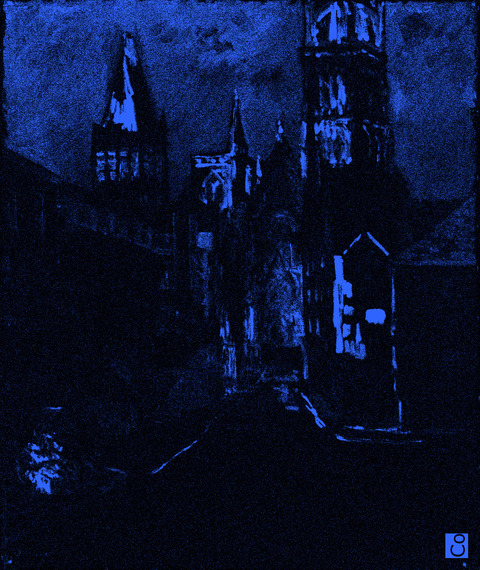
Two different green pigments were identified in this painting. The detection of copper and arsenic in the MA-XRF scan is indicative of the use of emerald green to depict the leaves of the potted plants on the left-hand side. It is also found in mixtures throughout the shadowy passages in the center of the composition, as well as the roof on the upper right and in the windows of the upper towers of the church. Chromium was detected with MA-XRF in green passages, indicating the likely use of viridian. This cooler green pigment was used for blue-green passages, such as the shadows of the potted plants, windows on the building in the foreground on the right, shadows under the awnings, and the figure in the middle distance (fig.23).
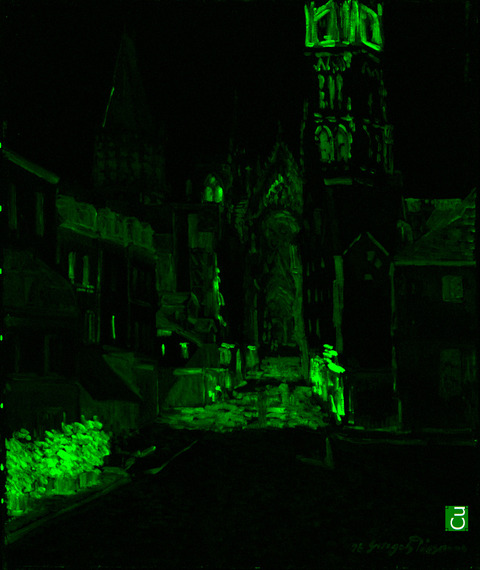

Two red pigments were identified in the painting. The red chimney flues are painted with dabs of vermilion paint, as indicated by the detection of mercury with MA-XRF (fig. 24). Vermilion was used to create the browns on the lower parts of the buildings, as well as the terra-cotta roofs. Both red lakes and vermilion were used in the signature. In a cross section taken from the signature (Sample a), large, translucent red particles were observed (fig. 25). SEM-EDS detected aluminum in these particles, which suggests the presence of an alum substrate red lake pigment (fig. 26).14 It is likely that a red lake (fig. 27) was used for the red signs on the side of the building on the right, as no mercury was detected in those areas with MA-XRF.

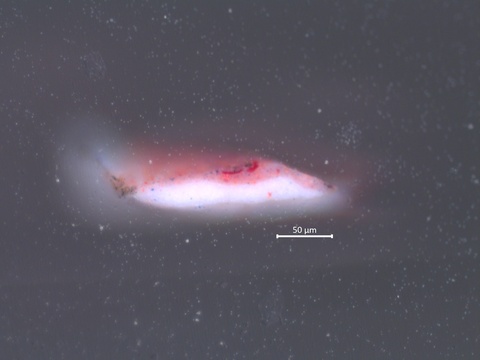

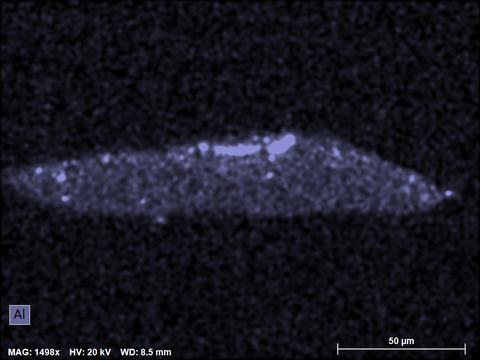

Condition of Paint
There are minimal cracks visible throughout the painting. Localized cracks are observable only under magnification, concentrated in passages of thickly applied paint with a higher proportion of white mixed in (fig. 28). There are small oblong holes seen throughout many paint passages that appear to be associated with the speed of paint application (fig. 29). Other bubbles are round and may be associated with the binding medium (figs. 30, 31). This phenomenon is also seen in paintings by Lucien. In a study of Pissarro paintings in the Courtauld Gallery’s collection, it has been posited that Lucien may have used commercial oil paints that contained water. The bubbles may have formed as a result of the water evaporation.15
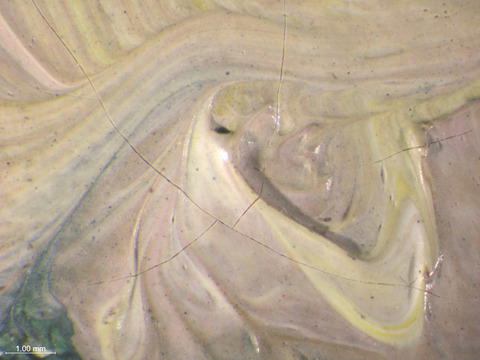
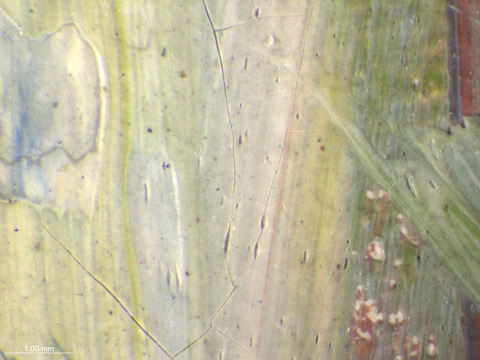
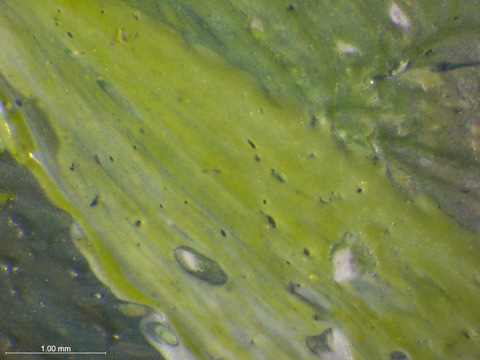
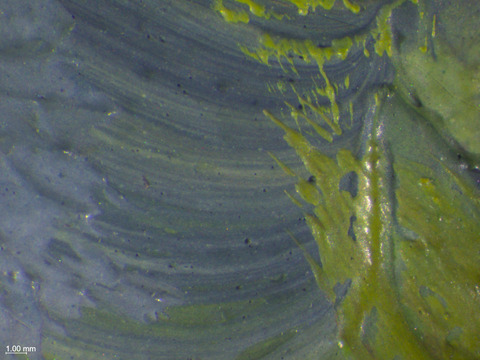
Description of Varnish/Surface Coating
The painting remains unvarnished and maintains a matte appearance (fig. 30).
Analyzed Observed Documented
| Type of Varnish | Application |
|---|---|
| Natural resin | Spray applied |
| Synthetic resin/other | Brush applied |
| Multiple Layers observed | Undetermined |
| No coating detected |
Condition of Varnish/Surface Coating
The inpainting undertaken in the 1980s is visible under ultraviolet irradiation (fig. 32). There is a layer of dirt on the surface of the paint layer that contributes to the painting’s overall matte appearance. A photomicrograph shows the dirt sitting on the peaks of the paint (fig. 33).
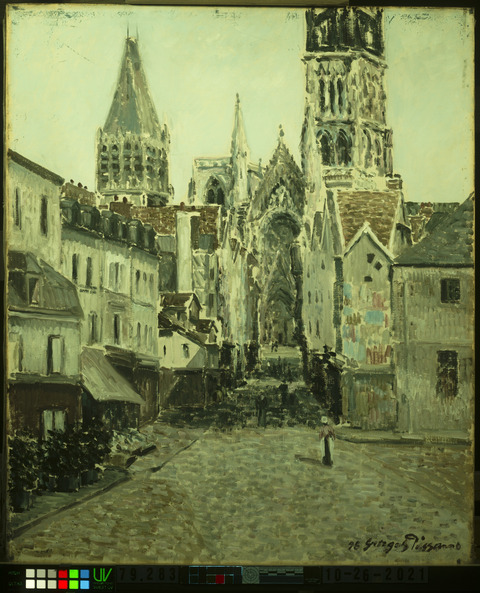
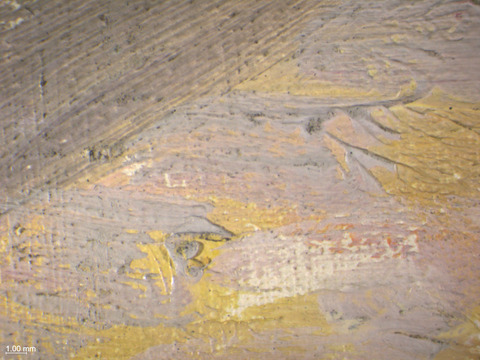
Description of Frame
Original/first frame
Period frame
Authenticity cannot be determined at the time/ further art historical research necessary
Reproduction frame (fabricated in the style of)
Replica frame (copy of an existing period frame)
Modern frame
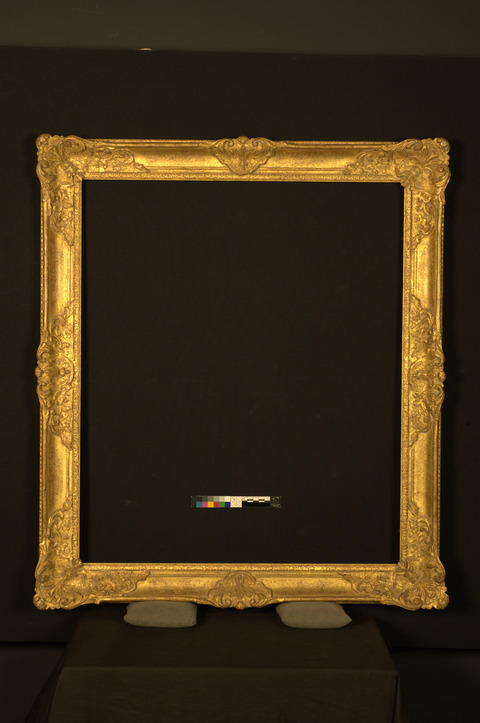
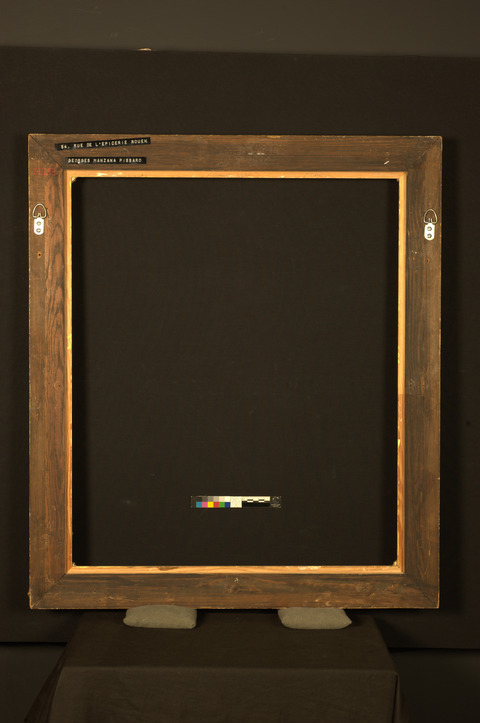
Frame Dimensions:
Outside dimensions: 80.6 × 70.5 cm
Rebate dimensions: 65.4 × 54.6 cm
Sight size dimensions: 63.3 × 52.7 cm
Rail width: 8.3 cm
Distinguishing Marks:
Top rail; left; two black plastic strips from mechanical label-maker, white letters in relief:
“54. RUE DE L’EPICERIE ROUEN”
“GEORGES MANZANA PISSAR[]O”
Description Of Molding/Profile:
The primary frame measures 6.9 cm and is constructed from a wood substrate with applied ornament. The profile borrows from Louis XIV/Régence design influences (fig. 34). There is a dentil bead design along the outer back edge and a narrow scotia. The front cove has unworked reposes, embellished foliate corners and fleur-de-lis mid-rails on a crosshatched ground, with trailing flower and stem ornament. The sight edge has a narrow taenia and an applied band of leaf and bud ornament on a hatched background with a cavetto edge. The surface finish comprises a layer of acrylic gesso, molded applied ornament, a red pigmented ground, and gold leaf. There is in-gilding along the back edges and the leaf lay-lines are visible. Imitation flyspecks, painted flaws, and abrasions have been applied to antique the tone of the finish.
The secondary linen-covered flat slip frame has a slant sight edge, measures 2.5 cm, and is secured into the rabbet of the primary frame with brass mending plates. This liner is acting as a spacer to keep the glazing from touching the canvas.
Both the primary and slip frames have 45-degree miter joinery and are secured at the corners with nails (fig. 35).
Condition of Frame
The frame is structurally secure. The composition ornament and the gilded finish are in fair condition. The ornament has a few stress cracks typical of composition. Overall, the applications and the gilded finish are not carefully rendered.
Notes
-
Woman Bathing her Feet in a Brook in the IMA collection displays this same logo. See Pissarro Paintings and Works on Paper at the Art Institute of Chicago, The Art Institute of Chicago, 2015 ↩︎
-
The Paris gallery, listed at 16 Rue Lafitte, was in the location from 1888 to 1924. The New York location listed is from Durand-Ruel’s third gallery there, which was at 389 Fifth Avenue from 1894 to 1904. See P.L. Durand-Ruel and F. Durand-Ruel, ed., Paul Durand-Ruel: Memoirs of the First Impressionist Art Dealer (1831–1922) (Paris: Flammarion, 2014), 208. ↩︎
-
See Stern Gallery, Georges Manzana Pissarro (London: Stern Gallery; Paris: Galerie Privarte, 2001). ↩︎
-
P.L. Durand-Ruel and F. Durand-Ruel, ed., Paul Durand-Ruel: Memoirs of the First Impressionist Art Dealer (1831–1922) (Paris: Flammarion, 2014), 219. ↩︎
-
See Letter to Lucien from Eragny, 26 May 1894, J. Rewald, ed., Camille Pissarro: Letters to His Son Lucien (Boston: MFA Publications, 2002), 234. ↩︎
-
See Letter to Lucien from Rouen, 19 August 1898, in J. Rewald, ed., Camille Pissarro: Letters to His Son Lucien (Boston: MFA Publications, 2002), 329. ↩︎
-
Double-ended tacks were often used to separate wet paintings from each other when in transit. See A. Callen, The Work of Art: Plein Air Painting and Artistic Identity in Nineteenth-Century France (London: Reaktion Books, 2014). ↩︎
-
In a letter to Lucien presumably written on his way back via Paris, the location noted in the letter, dated 1 November 1898. See J. Rewald, ed., Camille Pissarro: Letters to His Son Lucien (Boston: MFA Publications, 2002), 330. In the previous letter dated 13 October 1898, Camille mentions he will leave Rouen. See J. Rewald, p.330. ↩︎
-
M.J. Radecki, Indianapolis Museum of Art Examination Report, 28 September 1982, Conservation Department Files, Indianapolis Museum of Art at Newfields. ↩︎
-
The date of the report is uncertain, but probably contemporaneous with the examination report. The examination report is dated to 28 September 1982, which likely provides a terminus post quem (earliest possible) date for the conservation report. M. J. Radecki, Indianapolis Museum of Art Treatment Report, (1982?), Conservation Department Files, Indianapolis Museum of Art Conservation at Newfields. ↩︎
-
D.H. Johnson, Thread Count Report: Rue de L’Epicerie George Pissarro 1898 (Epicerie/79.283) from the Indianapolis Museum of Art, December 2021, p. 1 ↩︎
-
See Bourgeois aîné’s 1888 table of ready-stretched canvases reproduced D. Bomford et al., Art in the Making: Impressionism (London: National Gallery in association with Yale University Press, 1991), 46. ↩︎
-
D.H. Johnson, Thread Count Report: Rue de L’Epicerie George Pissarro 1898 (Epicerie/79.283) from the Indianapolis Museum of Art, December 2021, p. 3, Conservation Department Files, Indianapolis Museum of Art at Newfields. ↩︎
-
Aluminium-containing alum is commonly used as a substrate for red lake pigments. ↩︎
-
Lydia Gutierrez and Aviva Burnstock, “Technical Examination of Works by Camille and Lucien Pissarro from the Courtauld Gallery,” ArtMatters 5 (2013): 19, https://www.amjournal.org/_files/ugd/14a82d_1cd5fda55c9d4cdbb5cf6168377f1fd2.pdf. See also A. Callen, The Art of Impressionism: Painting Technique & The Making of Modernity (New Haven: Yale University Press, 2000), 101. ↩︎
Additional Images







